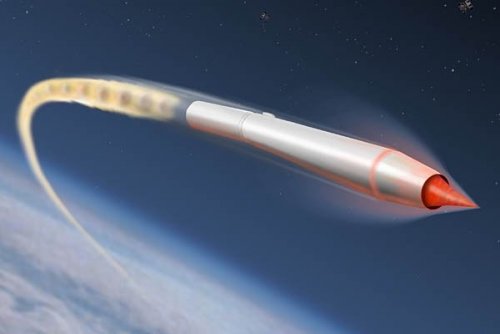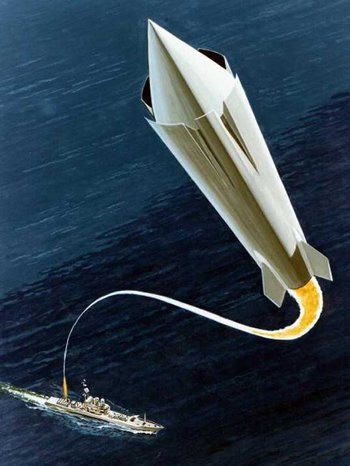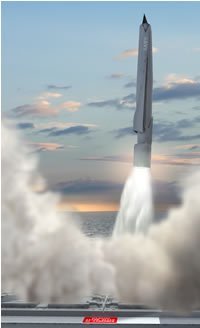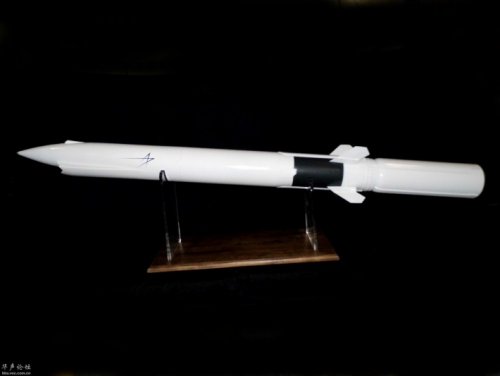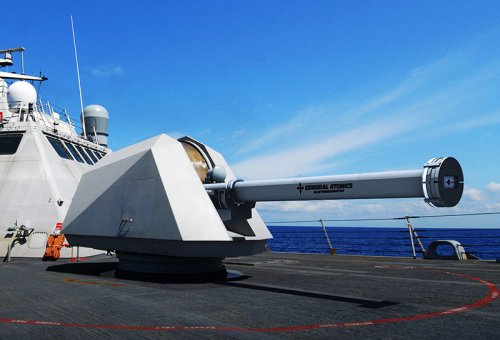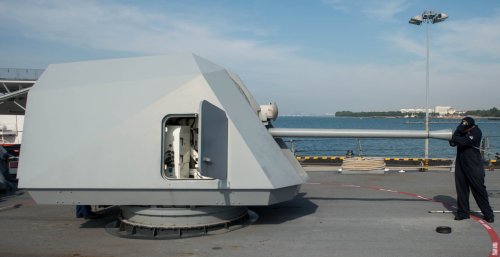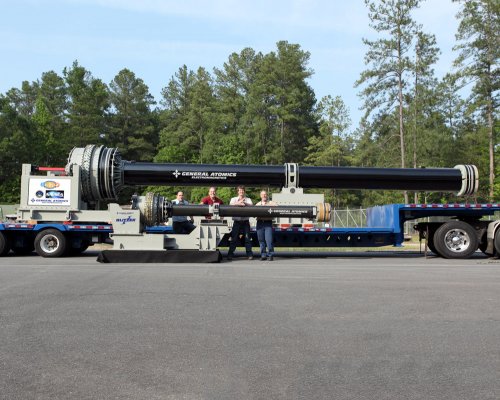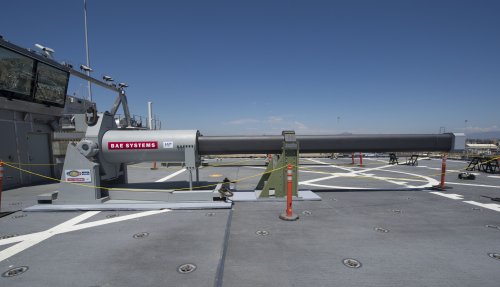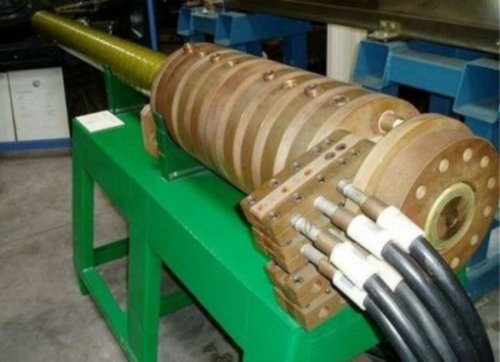You are using an out of date browser. It may not display this or other websites correctly.
You should upgrade or use an alternative browser.
You should upgrade or use an alternative browser.
Navy Seeks Rail Guns, Lasers, Cruise Missiles To Improve Pacific Firepower
- Thread starter Triton
- Start date
- Joined
- 3 June 2011
- Messages
- 18,305
- Reaction score
- 12,129
bobbymike said:http://www.realcleardefense.com/articles/2017/07/17/us_navy_on_the_cutting_edge_of_directed_energy_weapons_111828.html
But what will they do with it? Given they cancelled the Zumwalts I'm guessing, "not a damn thing". (Though no doubt the various databases will be pillaged to give the Chinese a leg up. As usual.)
- Joined
- 21 April 2009
- Messages
- 13,732
- Reaction score
- 7,617
Multi-shot Salvo
https://www.nextbigfuture.com/2017/07/us-navy-railgun-field-demo-ready-and-shows-video-of-4-8-shots-per-minute.html
I timed the shots, 2 in 24sec, or ~5/minute. We're getting there..... B)
https://www.onr.navy.mil/en/Media-Center/Press-Releases/2017/Electromagnetic-Railgun-Expo-2017
https://www.nextbigfuture.com/2017/07/us-navy-railgun-field-demo-ready-and-shows-video-of-4-8-shots-per-minute.html
I timed the shots, 2 in 24sec, or ~5/minute. We're getting there..... B)
https://www.onr.navy.mil/en/Media-Center/Press-Releases/2017/Electromagnetic-Railgun-Expo-2017
bring_it_on
I really should change my personal text
- Joined
- 4 July 2013
- Messages
- 3,638
- Reaction score
- 3,753
Pentagon seeks concepts for 'advanced' hypervelocity projectile
I always though that this was supposed to utilize the HAMMR given earlier SCO comments on an air defense sensor that leveraged a fighter radar. It would be interesting to see whether that is the case or if what the design solutions are.
The Pentagon is researching concepts for an “advanced” hypervelocity projectile as part of the Strategic Capabilities Office's initiative to outfit existing artillery systems with the ability to shoot down ballistic missiles.
The Missile Defense Agency released a request for information on behalf of SCO July 26 seeking input on "advanced HVP concepts in support of future capabilities being considered by the Department of Defense and MDA."
The advanced projectile the SCO seeks would be capable of surviving and operating at "extreme launch velocities . . . for extended ranges," according to the notice. It offers the example of installing an "advanced thermal protection system" on the projectile.
The advanced HVP concepts are being developed in support of "Project Icarus," according to the notice. Project Icarus has not been detailed publicly, and a Pentagon spokesman declined to describe it. The RFI document attached to the notice is classified as For Official Use Only (FOUO) and "Export Controlled Information."
The SCO's Hypervelocity Gun Weapon System has been one of the secretive office's most high-profile projects. The program seeks to modify the Army's Paladin 155 mm howitzers and the Navy's Mk-45 5-inch guns with the ability to shoot smart projectiles for missile defense missions, as well as an extended-range offensive punch. The SCO is also considering advanced powder gun prototypes and the Navy's effort to develop an electromagnetic railgun.
"Cost-effective, large magazine point defense will be demonstrated by closing the fire control loop between existing sensors and prototype projectiles launched from existing families of powder guns," budget documents state regarding the Hypervelocity Gun Weapon System.
Last fall, MDA sought ideas for a fire control sensor to be used as part of the hypervelocity weapon.
The SCO is seeking $67 million in fiscal year 2018 for the Hypervelocity Gun Weapon System, significantly less than the $246 million in funding the program received in FY-17, budget documents show.
The office's FY-18 plans include completing the advanced projectile's design concepts, delivering prototype fire control radar, completing prototype surveillance radar modifications and "conducting increasingly difficult fly-by engagements of live targets," according to the documents.
I always though that this was supposed to utilize the HAMMR given earlier SCO comments on an air defense sensor that leveraged a fighter radar. It would be interesting to see whether that is the case or if what the design solutions are.
bobbymike said:http://www.realcleardefense.com/articles/2017/08/03/fight_fire_with_fire_111959.html
Been lobbying for this for years.
Can the United States military detect and target the transporter-erector-launcher (TEL) of the DF-21/DF-26 before launch to make the IRBM a viable weapon? A series of pre-emptive strikes using sea-based IRBMs with conventional warheads to eliminate the DF-21/DF-26 threat to the United States Navy Carrier Strike Group (CSG) and/or Expeditionary Strike Group? How would such an armed clash between the People's Republic of China and the United States not escalate from a conventional to a nuclear war?
- Joined
- 21 April 2009
- Messages
- 13,732
- Reaction score
- 7,617
A question a person would ask in any conflict between two nuclear armed nations. The US has 'duel use' systems now, like its bomber force. An adversary wouldn't know if the next wave of air launched cruise missiles were armed with nukes. If this missile was a new design only ever discussed and tested as a conventional weapon I would think China detecting a launch would equate it as such.Triton said:bobbymike said:http://www.realcleardefense.com/articles/2017/08/03/fight_fire_with_fire_111959.html
Been lobbying for this for years.
Can the United States military detect and target the transporter-erector-launcher (TEL) of the DF-21/DF-26 before launch to make the IRBM a viable weapon? A series of pre-emptive strikes using sea-based IRBMs with conventional warheads to eliminate the DF-21/DF-26 threat to the United States Navy Carrier Strike Group (CSG) and/or Expeditionary Strike Group? How would such an armed clash between the People's Republic of China and the United States not escalate from a conventional to a nuclear war?
Trading IRBM volleys seemed better than losing a carrier or two by bringing them into the A2AD threat zone.
Also, at current deployed stockpiles I'd think China would be deterred from shooting a nuke first.
- Joined
- 3 June 2011
- Messages
- 18,305
- Reaction score
- 12,129
Triton said:bobbymike said:http://www.realcleardefense.com/articles/2017/08/03/fight_fire_with_fire_111959.html
Been lobbying for this for years.
Can the United States military detect and target the transporter-erector-launcher (TEL) of the DF-21/DF-26 before launch to make the IRBM a viable weapon? A series of pre-emptive strikes using sea-based IRBMs with conventional warheads to eliminate the DF-21/DF-26 threat to the United States Navy Carrier Strike Group (CSG) and/or Expeditionary Strike Group? How would such an armed clash between the People's Republic of China and the United States not escalate from a conventional to a nuclear war?
Many nations have had nuclear armed cruise missiles over the past half century-plus yet, despite the use of thousands of cruise missiles over the years, nobody has managed to start WWIII. That said, if we hit their TELs on Chinese soil with conventional missiles what's to keep them from hitting things like, oh, Whiteman AFB, or Norfolk, or Electric Boat, etc. etc. with conventional missiles?
bring_it_on
I really should change my personal text
- Joined
- 4 July 2013
- Messages
- 3,638
- Reaction score
- 3,753
Navy buying 'proven laser weapon' system for destroyers
The Navy is looking to buy a 60-150 kW high energy laser weapon system with an integrated counter intelligence, surveillance and reconnaissance laser for non-destructive dazzling capabilities against unmanned aerial vehicle-mounted sensors, according to a Federal Business Opportunities notice.
The High Energy Laser with Integrated Optical-dazzler and Surveillance project will "prioritize technical maturity and proven laser weapon concepts," the notice said.
The request for proposals seeks two test units to be delivered in fiscal year 2020, one of which is for an Arleigh Burke-class destroyer, DDG 51 Flight IIA. The second unit will be delivered to White Sands Missile Range in New Mexico before being transferred to Point Mugu in California, Naval Sea Systems Command spokeswoman Colleen O'Rourke wrote in a Aug. 15 statement to Inside the Navy.
Asked if the Navy will consider equipping Flight III with the laser weapon system, O'Rourke said the service is only targeting Flight IIA.
The RFP also includes options for an additional nine ship-based systems, O'Rourke added.
"The HELIOS Test Units shall include all necessary power, cooling, and processing hardware and software, along with all cables, interfaces, and displays necessary to operate and maintain the system on both a Land Based Test Facility and on a DDG 51 FLT IIA," the notice said.
HELIOS has $63.2 million budgeted for FY-18; $83.8 million for FY-19; $60.2 million for FY-20; $45.9 million for FY-21 and $30 million for FY-22, according to the Navy's budget justification documents.
bring_it_on
I really should change my personal text
- Joined
- 4 July 2013
- Messages
- 3,638
- Reaction score
- 3,753
Navy extending effort to define potential Tomahawk follow-on program
Following a year of exploring potential options for a next-generation cruise missile for its ships and submarines, the Navy is not ready to commit to a new acquisition program and instead plans to extend its Next-Generation Land Attack Weapon analysis of alternatives.
A top Navy official said the service, which last May estimated completing the NGLAW AOA between January and March 2018, is continuing to assess options for a Tomahawk follow-on, a requirement top Pentagon brass validated in 2016 to address anticipated capability gaps in the late 2020s.
"It's a work in progress," Rear Adm. Ronald Boxall, director of surface warfare (N96), said during a brief interview Jan. 11 at the Surface Navy Association annual conference. Pressed for a new completion estimate of the AOA -- which is being eyed closely by major defense contractors, including Raytheon, Lockheed Martin, Northrop Grumman and BAE Systems -- Boxall replied, "It is fair to say I can't give you a date."
Last February, in response to a Navy solicitation, industry provided feedback to the government team spearheading the AOA. The analysis was chartered to assess potential materiel solutions to mitigate gaps documented in the NGLAW initial capabilities document validated by the Joint Requirements Oversight Council during the summer of 2016.
"We're trying to determine the timeline for the [NGLAW] AOA because there are a lot of fingers in that pie right now," Boxall said.
Asked if the delay stemmed from new questions about the NGLAW requirements, the two-star admiral said, "We're very sure about the requirements. NGLAW is a long-term kind of view. What we're trying to do now is reconcile where we are with where we want to go with NGLAW in the future."
The Navy's larger Next-Generation Strike Capability cruise missile modernization strategy includes NGLAW, which is intended to hit land targets and also provide an ancillary capability to sink ships from submarines and ship canisters. The other program is the Offensive Anti-surface Warfare Increment 2 program, which is slated to provide air-launched, anti-ship missile capability by 2024.
- Joined
- 3 June 2011
- Messages
- 18,305
- Reaction score
- 12,129
God help them if they were forced to make a decision. I mean it's not like they've never considered these questions before. I swear to baby Jesus they must think if they just talk about it enough it will magically appear in the cells of ships. One can't help but wonder where they'd be if they hadn't thrown in the towel on RATTLRS, Fasthawk, or HyFly. As I recall they quit LRASM-B almost before the ink was dry on the announcement.
Attachments
- Joined
- 1 May 2007
- Messages
- 2,593
- Reaction score
- 1,958
Just spotted this over on MSN News, article originally from International Business Times . . .
https://www.msn.com/en-gb/news/world/chinese-navy-ship-reportedly-spotted-with-a-deadly-electromagnetic-railgun-%E2%80%93-see-images/ar-BBIxXOs?li=AAnZ9Ug&ocid=mailsignout
cheers,
Robin.
https://www.msn.com/en-gb/news/world/chinese-navy-ship-reportedly-spotted-with-a-deadly-electromagnetic-railgun-%E2%80%93-see-images/ar-BBIxXOs?li=AAnZ9Ug&ocid=mailsignout
cheers,
Robin.
It's interesting that BAE's gun barrel is quite a bit longer than this potential Chinese gun's barrel. Possibly by 30%. Hard to tell exactly. And that's not taking into account the seemingly thicker barrel on the Chinese gun.
It would appear there are some different solutions applied there, technology wise. Or the requirements were different. Maybe Chinese don't need as speedy rounds. Or they DO need them but they've managed to accelerate the round as much as BAE and make it as precise as BAE with a shorter barrel...
It would appear there are some different solutions applied there, technology wise. Or the requirements were different. Maybe Chinese don't need as speedy rounds. Or they DO need them but they've managed to accelerate the round as much as BAE and make it as precise as BAE with a shorter barrel...
- Joined
- 3 June 2011
- Messages
- 18,305
- Reaction score
- 12,129
totoro said:It's interesting that BAE's gun barrel is quite a bit longer than this potential Chinese gun's barrel. Possibly by 30%. Hard to tell exactly. And that's not taking into account the seemingly thicker barrel on the Chinese gun.
It would appear there are some different solutions applied there, technology wise. Or the requirements were different. Maybe Chinese don't need as speedy rounds. Or they DO need them but they've managed to accelerate the round as much as BAE and make it as precise as BAE with a shorter barrel...
General Atomics' railgun is roughly the same length as BAEs.
- Joined
- 4 July 2010
- Messages
- 2,512
- Reaction score
- 3,083
Recent intel estimates had the Chinese EMRG program still a ways from where one would expect a sea trial, if that is what we're seeing then rather than different solutions I wonder if we're simply seeing the result of them showing more than they actually have. There's enough odd about this mount that I wonder if they aren't rushing to show off a demonstrator before they've solved some of the essential problems, simply to have a demonstrator. If you took one of the old Dahlgren lab guns and wrapped a turret-like shell around it, the result might look something like what they're showing here.totoro said:It's interesting that BAE's gun barrel is quite a bit longer than this potential Chinese gun's barrel. Possibly by 30%. Hard to tell exactly. And that's not taking into account the seemingly thicker barrel on the Chinese gun.
It would appear there are some different solutions applied there, technology wise. Or the requirements were different. Maybe Chinese don't need as speedy rounds. Or they DO need them but they've managed to accelerate the round as much as BAE and make it as precise as BAE with a shorter barrel...
At any rate, bears monitoring.
- Joined
- 3 June 2011
- Messages
- 18,305
- Reaction score
- 12,129
fredymac said:The picture conveniently wraps the barrel so you can't tell but I guess people are using the Blitzer railgun for comparison.
I'm fairly certain the Bltizer railgun is a HELL of a lot bigger and heavier than the MK110 gun there. (Blitzer is on the truck in the back. The one in the foreground is a model of a smaller gun they're thinking about.)
Attachments
- Joined
- 16 April 2008
- Messages
- 9,586
- Reaction score
- 14,416
That's the Multi-mission Medium Range Railgun GA revealed in 2016.
http://www.navyrecognition.com/index.php?option=com_content&view=article&id=3455
The name Blitzer is used kind of indiscriminately. It's applied to GAs testbed, which is ~3 MJ, fits neatly on the back of a flatbed and looks to be about the size of the gun in the Mk110 housing.
But it's also applied to the ultimate Navy railgun (5-inch or even AGS replacement), which is an order of magnitude more powerful (somewhere around 20, 32, or even 64 MJ, depending on who you ask)
http://www.navyrecognition.com/index.php?option=com_content&view=article&id=3455
The name Blitzer is used kind of indiscriminately. It's applied to GAs testbed, which is ~3 MJ, fits neatly on the back of a flatbed and looks to be about the size of the gun in the Mk110 housing.
But it's also applied to the ultimate Navy railgun (5-inch or even AGS replacement), which is an order of magnitude more powerful (somewhere around 20, 32, or even 64 MJ, depending on who you ask)
- Joined
- 21 January 2015
- Messages
- 12,096
- Reaction score
- 16,233
robunos said:Just spotted this over on MSN News, article originally from International Business Times . . .
https://www.msn.com/en-gb/news/world/chinese-navy-ship-reportedly-spotted-with-a-deadly-electromagnetic-railgun-%E2%80%93-see-images/ar-BBIxXOs?li=AAnZ9Ug&ocid=mailsignout
cheers,
Robin.
More analysis here.
https://www.popularmechanics.com/military/research/a15957655/china-railgun/
DrRansom
I really should change my personal text
- Joined
- 15 December 2012
- Messages
- 701
- Reaction score
- 300
It seriously looks like China is going to beat the USN in testing a railgun at sea.
Yay for assured American technological superiority. : Maybe this might get the USN R&D leadership a kick in the pants, but who knows?
Maybe this might get the USN R&D leadership a kick in the pants, but who knows?
Yay for assured American technological superiority. :
- Joined
- 3 June 2011
- Messages
- 18,305
- Reaction score
- 12,129
DrRansom said:It seriously looks like China is going to beat the USN in testing a railgun at sea.
Yay for assured American technological superiority. :Maybe this might get the USN R&D leadership a kick in the pants, but who knows?
China realizes you have to do more than talk and show power points, you have to have a PLAN. In rail guns, hypersonics (or even supersonic) the word that best describes the West in general, and the US in particular, is "aimless". The US has TWO railguns, built by two different companies, and what are they doing with them? Not much.
DrRansom
I really should change my personal text
- Joined
- 15 December 2012
- Messages
- 701
- Reaction score
- 300
I am in total agreement. The organization and thinking has produced >20 years of R&D yielding virtually no fielded systems. The US has pissed away its entire technological advantage.
We've reached a point where any strategy assuming GH tech superiority is laughable.
There are so many problems, but I think two are critical:
1. A pathological bent to delay development for the next big thing.
2. No patient long term technology development plans that exist outside of individual programs and are protected from short term fluctuations.
We've reached a point where any strategy assuming GH tech superiority is laughable.
There are so many problems, but I think two are critical:
1. A pathological bent to delay development for the next big thing.
2. No patient long term technology development plans that exist outside of individual programs and are protected from short term fluctuations.
- Joined
- 3 June 2011
- Messages
- 18,305
- Reaction score
- 12,129
DrRansom said:I am in total agreement. The organization and thinking has produced >20 years of R&D yielding virtually no fielded systems. The US has pissed away its entire technological advantage.
We've reached a point where any strategy assuming GH tech superiority is laughable.
There are so many problems, but I think two are critical:
1. A pathological bent to delay development for the next big thing.
2. No patient long term technology development plans that exist outside of individual programs and are protected from short term fluctuations.
3. Pathological terror of risk.
4. No PLAN. There was a program sometime back (don't recall which it was) that was successfully tested and then allowed to die on the vine. "The DoD hasn't stated a use for it" or some such. Basically, "this speedy missile is pretty cool but we don't have a clue what we'd use it for". (Insert Picard facepalm.)
- Joined
- 21 April 2009
- Messages
- 13,732
- Reaction score
- 7,617
While 2) is true in many instances I would add 2a) But also, overly long drawn out underfunded technology plans that when finally showing promise of the new tech get cancelled.sferrin said:DrRansom said:I am in total agreement. The organization and thinking has produced >20 years of R&D yielding virtually no fielded systems. The US has pissed away its entire technological advantage.
We've reached a point where any strategy assuming GH tech superiority is laughable.
There are so many problems, but I think two are critical:
1. A pathological bent to delay development for the next big thing.
2. No patient long term technology development plans that exist outside of individual programs and are protected from short term fluctuations.
3. Pathological terror of risk.
4. No PLAN. There was a program sometime back (don't recall which it was) that was successfully tested and then allowed to die on the vine. "The DoD hasn't stated a use for it" or some such. Basically, "this speedy missile is pretty cool but we don't have a clue what we'd use it for". (Insert Picard facepalm.)
- Joined
- 3 June 2011
- Messages
- 18,305
- Reaction score
- 12,129
That raises more questions than it answers. Why don't the larger copper discs go to the end of the barrel? Are they for cooling? Does it take a big jolt to get the round moving and maybe less to keep accelerating? Coil-gun first then railgun (maybe to reduce a giant arcing hotspot as the round goes from resting to moving)? ???
Is the rail gun considered to be a threat by the Raytheon lobby?
Similar threads
-
-
-
-
-
Strategic Capabilities Office - Hypervelocity Gun Weapon - Missile Defense
- Started by bring_it_on
- Replies: 105

